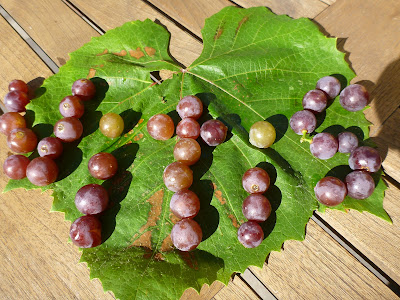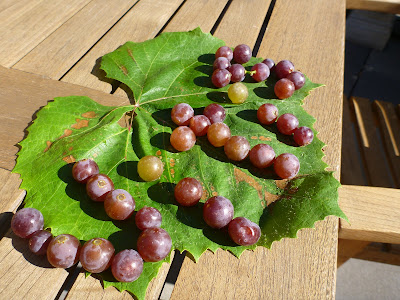Vitis Spelled with Concord Grapes (left) and Concord Grapes (right)
This year we had a good harvest of our Concord grapes. We harvested about 35 pounds of grapes of which 10 pounds was made into jam.
Two weeks ago we harvested the bulk of the grapes and took the binomen-themed pictures with the genus name Vitis spelled out with grapes arranged on a leaf. Today, on a brisk fall morning, we took photos with the jam jars and yellow-brown-green leaves.
Vitis is a genus of vining plants in the family Vitaceae. Concord grapes are a cultivar derived from the grape species Vitis labrusca. V. labrusca has thick leaves with a hairy underside with brown or white hairs. The slip-skin of the Concord grape is easily separated from the pulp ball.
Vitis labrusca has the common name of “Fox grape”. At first we thought it might derive from the Aesop Fable The Fox and the Grapes. But, it seems that the common name refers to the strong smell, “candied-strawberry/musky,” of the Concord grape. The Wikipedia entry for Vitis labrusca mentions that in the 1920s scientists identified the aroma as methyl anthranilate. This compound is secreted by the musk glans of foxes and dogs apparently. So which came first, the common name or the identification of the compound? In the book General Viticulture, the following appears (2nd Edition, page 167):
The foxy aroma of Vitis labrusca is among the most pronounced odors of grapes, and probably this fact attracted the investigators who some years ago isolated and identified the aroma substance as methyl anthranilate (Power and Chestnut, 1921). A well-matured Concord grape, ground under favorable conditions, may contain as much as 3.8 mg. of this aroma substance per liter of juice.
Quattrocchi says of Vitis etymology:
The Latin name for the grapevine, Latin vieo, -es, etum, ere “to bend, plait, weave,” Akkadian ebitu “to be tied, girt”; see Carl Linnaeus, Species Plantarum. 202. 1753 and Genera Plantarum. Ed 5. 95. 1754; Giovanni Semerano, Le origini della cultura europea. Dizionario della lingua Latina e de voci moderne. 2(2): 613, 616. Leo S. Olschki Editore, Firenze 1994.
On a side note, we learned that ampelograhy is a field of botany that deals with the identification and classification of grapevines, Vitis spp. Wikitionary gives the eytmology as deriving from the Greek ampelos for “vine” and graphē for “writing”. In older literature, the family name Vitaceae can be referred to as Ampleidaceae.
Jars of Concord Grape Jam on Colored Grape Leaves (left) and Grape Slip-Skin on Fall Leaf (right)
Jars of Concord Grape Jam on Colored Grape Leaves (left) and Vitis Spelled Out in Grapes (right)





No comments:
Post a Comment
All comments are moderated. If your comment doesn't appear right away, it was likely accepted. Check back in a day if you asked a question.